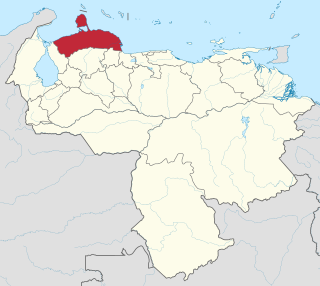Related Research Articles

Falcón State is one of the 23 states of Venezuela. The state capital is Coro.

Gitega is one of the 18 provinces of Burundi. Its capital is Gitega, which is also the national capital. It has a population of 725,223 as of 2008 and an area of 1,979 square kilometres (764 sq mi).

Polomolok, officially the Municipality of Polomolok, is a 1st class municipality in the province of South Cotabato, Philippines. As of May 2020, it has a population of 172,605 people making it the most populated municipality in Mindanao.

Ibotirama is a municipality located in the west of the state of Bahia, Brazil. It is in the micro-region of the lower-middle São Francisco River. This major river passes by the city where it is crossed by a recently constructed bridge. Ibotirama covers 1,740.087 km2 (671.851 sq mi), and has a population of 27,003 with a population density of 16 inhabitants per square kilometer. The municipality lies along the São Francisco River, a major inland water route and the fourth-longest river in Brazil.

Flores de Goiás is a municipality in northeastern Goiás state, Brazil.

Morrinhos is a municipality in southern Goiás state, Brazil. It is a large producer of agricultural products, especially poultry and dairy products.

Linares is one of four provinces of the central Chilean region of Maule (VII). The provincial capital and most populous center is the city of Linares.

Bambuí is a Brazilian municipality located in the west of the state of Minas Gerais. Its population as of 2020 was 23,898 people living in a total area of 1,455 square kilometres (562 sq mi), for a density of 15/km2 (39/sq mi). The city belongs to the meso-region of Oeste de Minas and to the micro-region of Piumhi. It became a municipality in 1881.
The Ruvyironza River is a river in Burundi, the main tributary of the Ruvubu River. Its headwaters are the most remote source of the Nile when measured by river length from the Nile's mouth.

Xochitlán Todos Santos (municipality) is one of the 217 town and municipalities of the Mexican state of Puebla. It was founded in 1895.
The commune of Nyarusange is a commune of Gitega Province in central Burundi.
The commune of Bugabira is a commune of Kirundo Province in northern Burundi. The capital is Bugabira. There are health centers at Muyange and Ruhehe.
Busoni is a commune of Kirundo Province in northern Burundi. The seat lies at Busoni.
The Commune of Bwambarangwe is a commune of Kirundo Province in northern Burundi.

The Natural regions of Burundi are geographical subdivisions of Burundi that date to colonial times. They can be broadly grouped into the Plain zone in the west beside Lake Tanganyika and the East African Rift valley, the Congo-Nile ridge, the Central Plateaus and the Depressions to the north, east and south of the plateaus.

The Mubarazi River is a river in Burundi, a major tributary of the Ruvubu River.
The Kaniga River is a river in Burundi.
The Kajeke River is a river in Bubanza Province, Burundi. It is a tributary of the Ruzizi River.
The Mutsindozi River is a river in southeastern Burundi, a tributary of the Malagarasi River.
The Nyakijanda River is a river in Burundi, a left tributary of the Nyabaha River.